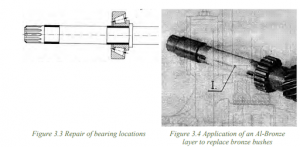Lesson 3: Methods that meet today’s requirements – flame metal spraying
In this lesson, we will explore one of the methods that meets today’s requirements for cost-effective individual and small series production, as well as achieving quality and durability exceeding the original – Flame Metal Spraying.
Introduction
In order to meet the new requirements for repair and renovation, i.e. to achieve cost-effective individual and small series production, and to achieve quality and durability that exceeds the original, the following methods have been widely used:
- Flame spraying of metallic powder
- Flux cored metal spraying welding
- Casting repair welding
- Hard metal surfacing
- Application of plastics
Flame Metal Spraying
- Overview
- Flame metal spraying, or more accurately, cold metal powder spraying, is a method that addresses these needs effectively.
- Basic equipment such as acetylene and oxygen cylinders is readily available, making it accessible even in simple locksmith shops.
- A wide range of alloy powders is commercially available.
- The process involves depositing spherical alloy powder onto the surface to be treated using a mixture of acetylene and oxygen, which becomes plasticized by heat.
- Procedure
- The sequence of operations includes preparation and cleaning of the component, pre-machining of the surface, application of a primer coat, application of filler powder, finishing, and quality control.
- Preparation involves cleaning the surface from physical and chemical contamination and testing its suitability.
- Pre-machining and roughening prepare the part’s shape and surface for bonding.
- Primer powder ensures stable adhesion.
- Filler powder composition is selected based on component material and expected stresses.
- Topcoat application follows specific rules like spray temperature control and machining allowance.
- Advantages
- Cold metal spraying offers flexibility in varying alloying elements.
- The resulting surface is corrosion-resistant and has excellent lubrication properties.
- Surface hardness can be controlled, making it suitable as a replacement for other surface treatments.
- Limitations
- Not suitable for dynamic loads.
- Unsuitable for point or linear contact.
- Should not be used in areas subject to high thermal stress.
- Applied layers can be porous.
- Applications
- Flame metal spraying finds applications in shaft bearing locations and bearing bushes.
Conclusion
- Flame metal spraying, or cold metal powder spraying, is a method that meets modern requirements for cost-effective repairs and renovations.
- It offers flexibility in alloy composition, corrosion resistance, and controlled hardness.
- While it has limitations, it is a valuable technique for specific applications.
